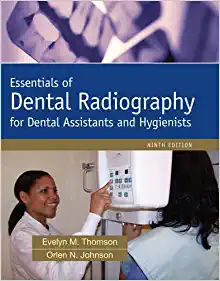Test Bank For Essentials of Dental Radiography 9th Edition By Evelyn Thomson, Orlen Johnson
ISBN-10: 0138019398, ISBN-13: 978-0138019396
Chapter 1
Multiple Choice
- d. Wilhelm Conrad Roentgen discovered the x-ray on November 8, 1895, when he noted that a fluorescent screen near a Crookes vacuum tube began to glow when an electric current was passed through the tube.
- b. Howard Riley Raper wrote the first dental radiology textbook, Elementary and Dental Radiology, and introduced bitewing radiographs in 1925.
- a. William David Coolidge developed the shockproof hot cathode tube while working for the General Electric Company in 1913.
- c. William Herbert Rollins was one of the first to alert the profession to the need for radiation hygiene and protection, and is considered by many to be the first advocate for the science of radiation protection.
- d. C. Edmund Kells took the first dental radiograph on a living subject in the United States. He was the first to put the radiograph to practical use in dentistry. Dr. Kells made numerous presentations to organized dental groups and was instrumental in convincing many dentists that they should use <KT>oral radiography</KT> as a diagnostic tool.
- a. Because x-rays are invisible, scientists and researchers working in the field of radiography were not aware that continued exposure produced accumulations of radiation effects in the body and therefore could be dangerous to both patient and radiographer.
- d. The introduction of the Coolidge tube allowed for an x-ray output that could be predetermined and accurately controlled.
- d. Dr. Otto Walkhoff, a German physicist, was the first to expose a prototype of a dental radiograph. This was accomplished by covering a small, glass photographic plate with black paper to protect it from light and then wrapping it in a sheath of thin rubber to prevent moisture damage during the 25 minutes that he held the film in his mouth.
- c. A rectangular position indicating device (PID) limits the size of the x-ray beam that strikes the patient to the actual size of the image receptor.
- d. Panoramic radiography</KT> became popular in the 1960s with the introduction of the panoramic x-ray machine.
- c. While cone beam volumetric imaging dedicated to dental applications produces less radiation doses than conventional CT scans, the dose is still 4 to 15 times that required for a panoramic radiograph.
- b. Early film had emulsion on only one side and required long exposure times.
- c. Pointed cones are no longer acceptable because x-rays are scattered through contact with the material of pointed cones.
- b. The bisecting technique is based on the rule of isometry, but this is not the reason that it was the first and earliest radiographic technique for exposing intraoral radiographs.
- a. Because the newer technique of paralleling improved on the older bisecting technique, it is the technique of choice and taught in all dental assisting, dental hygiene, and dental schools.
- a. In 1907, A. Cieszyński, a Polish engineer, applied the “<ITAL>rule of isometry”</ITAL> to dental radiology and is credited for suggesting the bisecting technique.
- d. Home care is best determined during a visual clinical examination that would assess the presence of biofilms and the condition of the gingival tissues.








Reviews
There are no reviews yet.